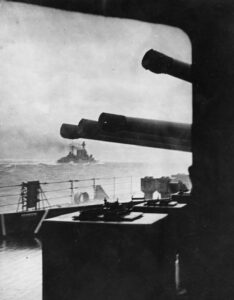Norway became the first country with a commercial plant for producing heavy water when Norsk Hydro went into operation in 1934. In 1940, Norway was invaded by Nazi Germany, and control of the plant fell into German hands. It now controlled most of the world’s heavy water production, which was an essential process in the race for developing nuclear weapons. With the start of World War II, German control of this process was very concerning to the British, and later to the American Allies, since this meant that Germany might win the race to weaponizing nuclear power before the Allies. They decided to remove the heavy water supply and destroy the plant by aiming raids targeting the power station supplying power to the commercial plant.1 However, prior to the German invasion of Norway, French military intelligence decided it would be necessary to remove a fraction of the heavy water and transport it to France during the war.2
Germany started to procure heavy water in late January 1940. In response, British Special Operations Executive (SOE) started planning several operations aimed at limiting or completely stopping German production of heavy water. The first operation, code-named Operation Grouse, launched on October 18, 1942.3 During this operation, four Norwegians parachuted onto a plateau above and near the Hydro plant. Their mission required them to gather as much information as they could regarding the plant and the heavy water operations. All the information that the team gathered was sent to SOE to plan for the next phase, code-named Operation Freshman. In this operation, a group of combat engineers were sent by gliders to join the Grouse team. Together, both teams were to set and detonate demolitions in key parts of the Hydro plant, and escape to Sweden.4
On November 19, 1942, Team Freshman left England to carry out their mission. However, the night of the operation, the weather conditions in the designated drop zones were extremely harsh, causing the first glider to crash into a mountain killing the entire crew. The second glider also crash landed, killing most of the people in the glider.5 Even after the gliders crashed, some of the crew members survived, but eventually they were captured by German soldiers, tortured, and eventually killed.
Due to the failed mission, Germans became aware of the Allied interest in the heavy water plant. This caused the Germans to increase the defenses in the perimeter, including establishing a mine field, floodlights, and deploying more guards on the site. However, this did not impede SOE. Planners continued to search for ways to send in commandos to link up with Team Grouse, which by now was renamed Team Swallow. All four members of Team Swallow lay low for several months in the mountains on top of the Hydro plant keeping contact with SOE by radio.6

After a while, SOE was able to finalize the plans for the next phase, Operation Gunnerside. In this operation, six more commandos parachuted in Norway on February 16-17, 1943. After several days, Team Swallow joined Team Gunnerside, and they started planning their assault, deciding to attack on February 27, 1943.
Several months had gone by since Operation Freshman, and the German defenses were still up, but security had become somewhat slacker. Only the bridge across the Maan River was still fully guarded, limiting their ways to get through the guards. The commandos realized that the only option they had to get inside was to climb down the 656 ft. ravine, cross the freezing river, and climb back up the other side of the ravine.7 Using information obtained, the teams then followed a rail line into the plant area without being detected by guards.
Once inside, they met with a Norwegian caretaker who assisted them in getting where they needed to be.8 The teams moved quickly into where the heavy water chambers were and placed the explosives, attaching a long time-delay fuse to the explosives. The saboteurs also made sure to leave a British sub-machine gun hoping to lead the Germans into thinking the sabotage was the British’s doing. They then lit the fuse the same way they came into the plant, and once they were clear of the plant, the explosives detonated destroying the heavy water chambers as well as 120 gallons of heavy water stored in the Hydro plant.

After the explosion, the Germans launched an all-out search for the commandos, but were unable to find them. All the commandos were able to escape the site, some into Sweden, others to Oslo, Norway, and some staying in the general area. After the successful execution, Germany started rebuilding the destroyed parts of the Hydro plant and produced more heavy water in the following months. SOE considered launching another operation but saw it as too difficult. So in November 1943 the US Army Air Forces were given orders to conduct bombing raids on the plant. Finally, after the bombing raids, the plant received extensive damage causing the Germans to halt production.
- Funk & Wagnalls New World Encyclopedia, 2016, s.v. “World War II.” ↵
- Funk & Wagnalls New World Encyclopedia, 2016, s.v. “World War II.” ↵
- Neal Bascomb, The Winter Fortress (Boston: Houghton Mifflin Harcourt, 2016), 30-35. ↵
- Neal Bascomb, The Winter Fortress (Boston: Houghton Mifflin Harcourt, 2016), 45. ↵
- Neal Bascomb, The Winter Fortress (Boston: Houghton Mifflin Harcourt, 2016), 109-111. ↵
- Janet Voke, “Hero of Telemark: Janet Voke meets Joachim Ronneberg, survivor of one of the most daring actions of the second World War: the sabotage of a German heavy water plant deep in occupied Norway,” History Today 60, no.10 (2010): 57-58. ↵
- Neal Bascomb, The Winter Fortress (Boston: Houghton Mifflin Harcourt, 2016), 189-192. ↵
- Janet Voke, “Hero of Telemark: Janet Voke meets Joachim Ronneberg, survivor of one of the most daring actions of the second World War: the sabotage of a German heavy water plant deep in occupied Norway,” History Today 60, no.10 (2010): 50-59. ↵



41 comments
Kenneth Gilley
What an interesting article! I had never heard of Operations Grouse, Freshman, or Gunnerside until I read this. Even if these operations didn’t halt the German atomic bomb research, at least they greatly hindered it. It is amazing that SOE continued to persevere in face of the failure of Operation Freshman. Thank goodness that the people in WWII fought so that we would be free of Nazi tyranny.
Mia Morales
I really enjoyed reading this article because I was unaware of this operation. It is fascinating to learn new things through these articles and to me this was interesting because I would have thought that this would be more talked about. I can only imagine how life would be now if this operation actually took place.
Antonio Coffee
I had never even heard that people were concerned with Hitler and the Nazis getting ahold of atomic power. I didn’t realize that this was even that much of a concern for the Allies and I am shocked that this operation is not talked about more often. This could have proved disastrous had the Nazis been able to obtain an atomic bomb. This sounds like something out of an action movie and it is really cool that it happened in real life.
Devin Ramos
This article was interesting because I have never heard of this operation. I really found it interesting and how the allies wanted this plant destroyed so the Nazis would not be able to create nuclear weapons. Even though the Germans increased their security the men living and collecting data were right under their noses which to me is the best part. Because of these men risking their lives, the Germans did not create nuclear weapons which could have changed the fate of the war.
Adrian Cook
This just goes to show if you fail the first time keep trying and you’ll get it the second time. This was a very risky mission I had never heard of and it’s a terrible tragedy that the first mission was a complete fail. I’m glad they got it the second time around with more help and were able to destroy the water chambers. Although Germany just built it again in the end, the Air Force were able to destroy it and halt production all together.
Jose Sanchez
Prior to this article, I was unaware of these military operations to stop this heavy water plant, nor that the Germans had control of it. This article was very well written and flowed well together. I could only imagine how critical this mission must have been. It also seems like it may make a good movie due to the high stakes, secret mission, and special ops.
Daniel Linstead
I never even heard anything in regards to this before reading this article. I think personally that it should be discussed more due to the fact it was an important part of the history. Sometimes it makes you wonder if these types of important details in the war that we don’t know about now where would we be. Because we don’t know every little detail that won the war so it makes you wonder.
Steven Hale
I find it amazing that the original four Norwegian commandos were living in German-held territory next to the plant for over four months before the attack took place. I would assume after the first failed attack and the increase in security that the German soldiers would have been especially wary of anyone hanging around the plant. Those commandos must have faced some incredibly tense and terrifying situations. This story would make a great film.
Thomas Fraire
This article sparkles a light on a story that appears little but could have been one of the most significant occasions in World War 2. One of the most curious things in this article, in my conclusion, is that the British SOE and organizers of the assault attempted to utilize a more sensible and less dangerous approach to the starting. In spite of the fact that in the conclusion they turned to discuss attacking, they started by looking at a more key arrange. This article too appears the bravery of the men on the ground. By including the story of the fizzled endeavor, the author makes a difference the perusers get a handle on how unsafe the mission truly was. By and large, it was a well-written and curiously article.
Jonathan Perez
This article seemed to be really well researched. The Nazi regime was one of incredible power and won can only imagine the horrors of what would have happened if they had gotten their hands on a nuclear weapon. The description of the mission was gripping and the patience that went into this operation is well described. Overall the article was really well written and delivered a story that not many are aware about.